LESSER KUDU
(Tragelaphus imberbis) |
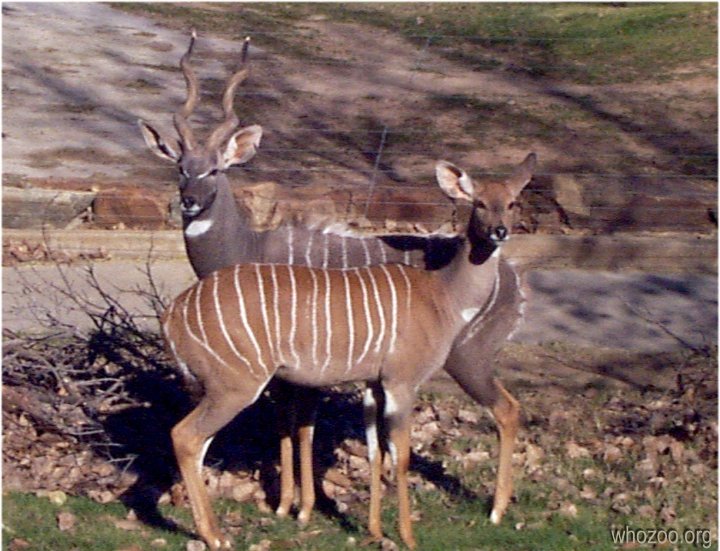
| Swahili Name: Tandala Ndogo | | Scientific Name: Tragelaphus imberbis | Size: Body length: 110-140cm/3.6-4.6 ft
Shoulder height:90-110cm/3-3.7ft
Tail lenght:25-40cm/10-16 in | | Weight:56-105kg/123-231lb | Life Span:7 to 8 years in the wild and up to 23 years incaptivity (average 15 years) | Life Cycle: Weaning: After 6 months
Sexually Maturity: Females by 15
months, males mature sexually at this
time, but not socially mature until 4th
or 5th year. | | Habitat: Dense bush or forest | | Diet: Herbivorous | | Gestation: 222 days | Predators:Leopards, hunting dogs, spotted hyenasand humans | | Range:Africa (Somalia) | | Location in the Zoo:African Hoofed Stock Exhibit |
General Information:The Lesser Kudu is one of the most beautiful antelopesin Africa. Kudus are considered by many one of the most handsome of thetragelaphine antelopes, which are: bongo, eland, nyala, bushbuck and sitatunga.Their beautiful horns are the origin of the obscure tradition of scouting:Their elegant spiral horns hollowed out as a wind instrument, are usedas signal horns to call Scout camps and training courses together. Thishappens all over the world. In Africa horns are also used for honey containers,musical instruments, and symbolic ritual instruments; the horns are thoughtto be the dwelling places of powerful spirits, and others as a symbol formale potency.
|
Physical Characteristics:
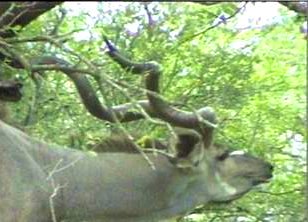 A lesser kudu is about 200 pounds and about 40 inchesat the shoulder. Kudus have stripes and spots on the body. They havewhite patches on the upper and lower parts of the neck, 11-15 very distinctivewhite stripes on the sides, a chevron between the eyes and a crest of longhair along the spine, there is no beard (imberbis=not bearded.) Male kuduare bluish-gray, grayish-brown, or have a rust color. Females and youngare reddish-brown. In general kudus have slender legs with black and whitemarkings. They have great spiral long horns. Horns can grow up to 72 inches,making 2&1/2 twists; occasionally females will have small horns. Thehorns are used in defense of predators; horns are not an impediment inwooded habitats; the kudu tilts the chin up and lays the horns againstthe back helping it to move easily through the dense bush. (The pictureabove shows a greater kudu as he moves through woodland)
|
| Habitat: Lesser kudus are originally from Africa (Somalia). They are found in acacia and commiphora thornbush in arid savannas; kudus inhabit the dry thorn-bush countries of Somalia, Ethiopia, Kenya and Tanzania ( Eastern Africa). Lesser kudus rely on thickets for security; the dense thickets in the plains of Africa provide the kudu cover in which to seclude itself. They are rarely found in the open or scattered bush.
|
Behavior: 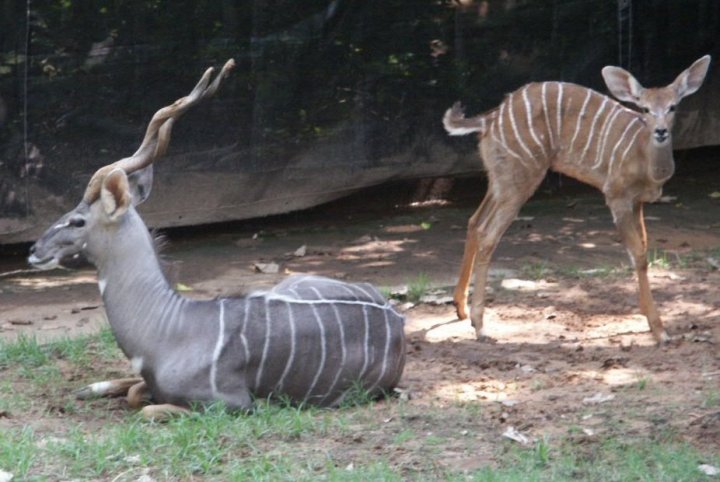 Lesser kudus are secretive by nature. They are shy and wary in the wild. They appear in the morning or late afternoon, eat twigs, leaves and young shoots. The rest of the day they remain secluded in dense vegetation; they are usually active at night, seeking shelter soon after sunrise. The hierarchy among males is determined by age and size. Males about the same age and size show their dominance in sparring contests in which they slowly approach one another, lock horns and push back and forth until one gives up; no serious injuries result, but remains of animals have been found where two combatants have locked their horns in such way that they could not disengage. This is just a way to show dominance, which is usually quick and peaceful; at the end this is determined by a lateral display in which one male stands sideways in front of the other trying to look as large as possible so, if the other is suitably impressed, dominance is established. The areas overlap extensively with no apparent territoriality, and different parts are used in different times of the year. Individual home range averages 2.2 square kilometers for males and about 1.8 for females. Population density rarely exceeds one animal per square kilometer. The alarm call is a sharp bark. Lesser kudus are secretive by nature. They are shy and wary in the wild. They appear in the morning or late afternoon, eat twigs, leaves and young shoots. The rest of the day they remain secluded in dense vegetation; they are usually active at night, seeking shelter soon after sunrise. The hierarchy among males is determined by age and size. Males about the same age and size show their dominance in sparring contests in which they slowly approach one another, lock horns and push back and forth until one gives up; no serious injuries result, but remains of animals have been found where two combatants have locked their horns in such way that they could not disengage. This is just a way to show dominance, which is usually quick and peaceful; at the end this is determined by a lateral display in which one male stands sideways in front of the other trying to look as large as possible so, if the other is suitably impressed, dominance is established. The areas overlap extensively with no apparent territoriality, and different parts are used in different times of the year. Individual home range averages 2.2 square kilometers for males and about 1.8 for females. Population density rarely exceeds one animal per square kilometer. The alarm call is a sharp bark.
|
| Diet: 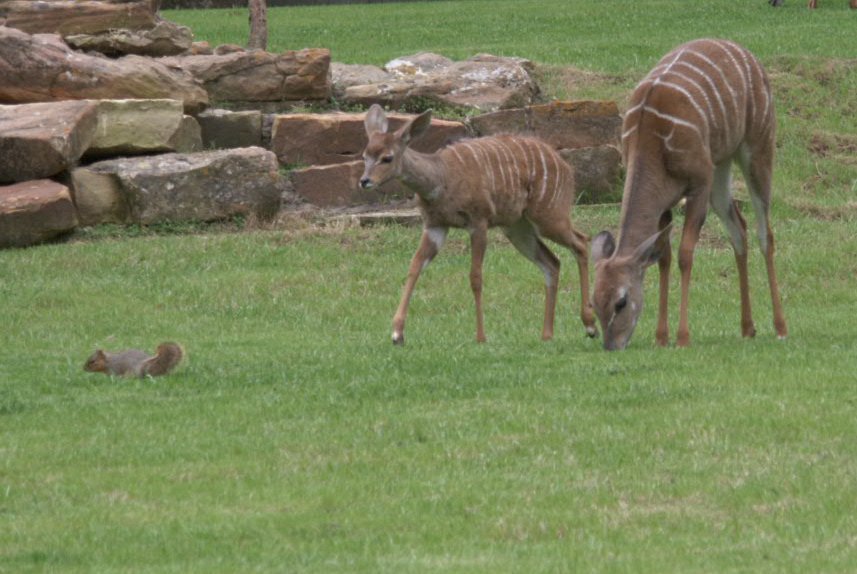 Kudus are herbivorous; they primarily eat leaves, young shoots, twigs, and sometimes grasses and fruits. Since they live in drier areas of eastern and southern Africa, and wherever there is adequate low and medium level woody growth to provide food and shelter, they are browsers and eat leaves, shoots and a variety of plants. In dry seasons, they eat wild watermelons and other fruit for the liquid they provide; they drink water whenever available, although it is possible for them to go a one month without water. Where farming has developed near their habitat, kudus will sometimes make nocturnal visits to plantations and vegetable plots. It takes high fences to stop them, since they can jump up to 6 feet. Kudus are herbivorous; they primarily eat leaves, young shoots, twigs, and sometimes grasses and fruits. Since they live in drier areas of eastern and southern Africa, and wherever there is adequate low and medium level woody growth to provide food and shelter, they are browsers and eat leaves, shoots and a variety of plants. In dry seasons, they eat wild watermelons and other fruit for the liquid they provide; they drink water whenever available, although it is possible for them to go a one month without water. Where farming has developed near their habitat, kudus will sometimes make nocturnal visits to plantations and vegetable plots. It takes high fences to stop them, since they can jump up to 6 feet.
|
Reproduction: 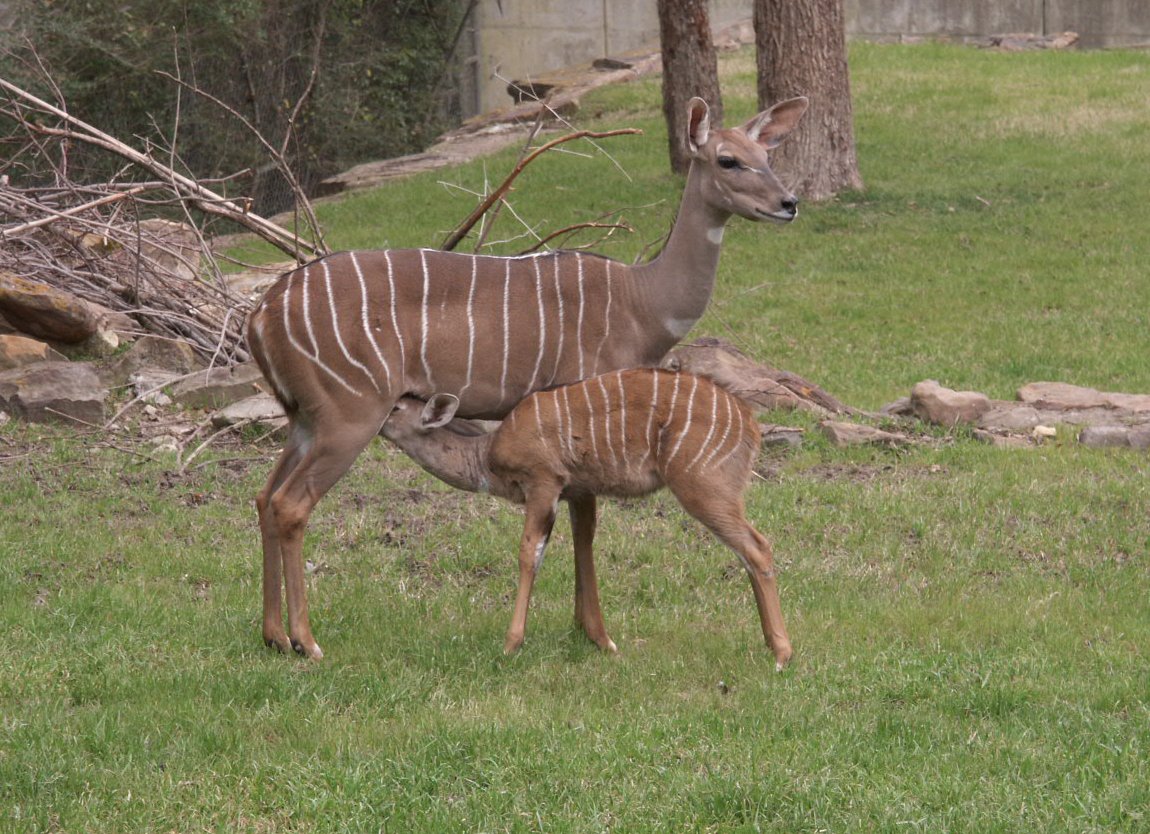 Gestation period is about 222 days or 8 months. They have only one young at the time; there is no fixed breed season and calves are born throughout the year. After birth, the young lie concealed away from their mother; the pregnant female departs from the group, leaving the newborn lying for four or five weeks, one of the longest periods of all the antelopes. Females and their offspring form small groups of 6 or 10. Males usually just join them during mating period. Gestation period is about 222 days or 8 months. They have only one young at the time; there is no fixed breed season and calves are born throughout the year. After birth, the young lie concealed away from their mother; the pregnant female departs from the group, leaving the newborn lying for four or five weeks, one of the longest periods of all the antelopes. Females and their offspring form small groups of 6 or 10. Males usually just join them during mating period.
Males stay with their mothers for about 2 years and thenbecome solitary, associating with females which are with their mothersonly temporarily. Males sometimes males form small bachelor groups, butmore commonly they are solitary and widely dispersed
Their weaning is after 6 months. Females are sexuallymature at about 15 months, males mature sexually at this time, althoughthey do not become socially mature until their 4th or 5th year. Their averagelife span is about 15 years, they can live 7 or 8 years in the wild and30 years in captivity.
|
| Avoiding Danger: When startled, a kudu flees with the tail held up, revealingthe white underside and runs in a "rocking horse" fashion, throwing itshindquarters and tail high into the air. They are capable of jumping 7feet into the air, (although its average is about 6 feet) often escapingdanger by jumping over a bush instead of going around or through it. Theirhorns are not an impediment in wooded habitats.
|
| Status: The lesser kudu is classified as a low risk, conservationdependent species by the IUCN
|
| Comments AboutLesser Kudu: The zoo has a male and a female, who are potential breeders.Both animals are from Africa (Somalia)
|
Personal Observations :I personally think lesser kudus are beautiful and verysmart. There is something that I want to share that happened to me thatday. The day I went to the zoo, it was empty. It was a Thursday afternoonand most of the zoo keepers were getting ready for some special event theywere going to have at night, so, I was basically by myself at the zoo,as I was taking pictures of the Lesser Kudu I realize that the female kuduwas hiding behind the male as if I was going to do something to her, themale was starring at me and seemed irritated. I have no idea what madehim so mad, I decided to leave after briefly talking to a zoo keeper, becauseI knew that my presence was making them uncomfortable. This incident helpme realize that they are smart they did not wanted me there and they letme know. |
 WhoZooHome WhoZooHome
AnimalIndes
|